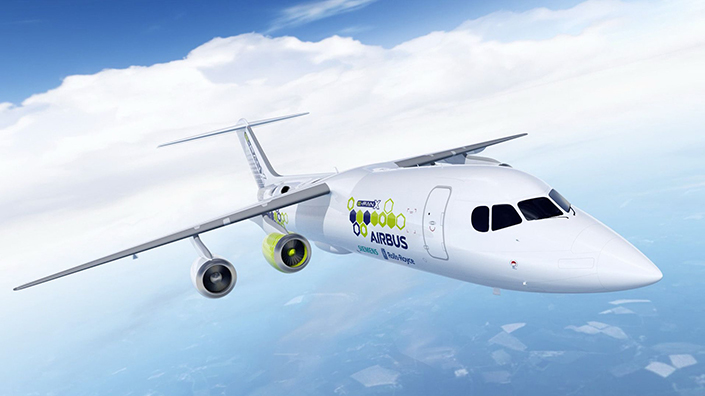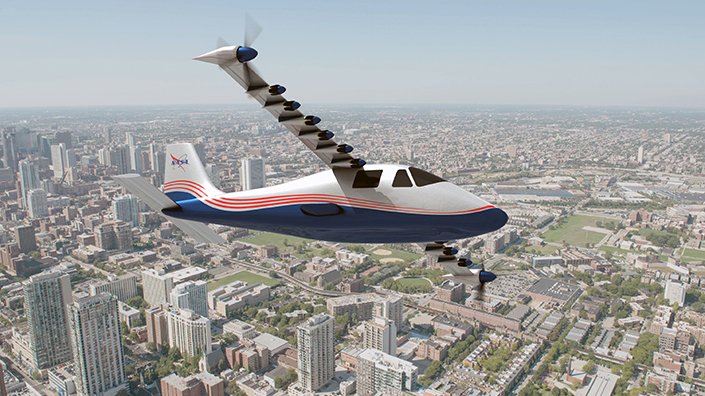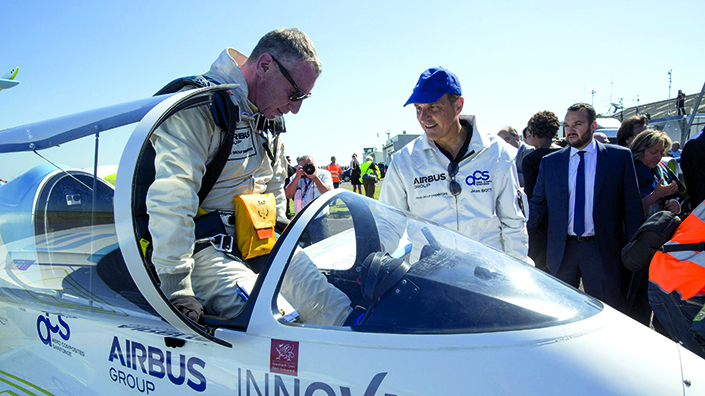On a bright morning near the turn of the century, a tiny one-manned aircraft set off to cross the English Channel, attempting to set a milestone in aviation history. The success or failure of the mission could determine the future of flight.
But this wasn’t the 20th century. It was the 21st. The aircraft was the E-Fan 1.0, the first all-electric aeroplane to cross the Channel.
If the stakes were high 100 years ago, they could be even higher now. With the aviation industry burning through five million barrels of oil a day, it could account for 22% of global emissions by 2050. As the stakes get bigger, so do the players – and the claims.
EasyJet has teamed up with US start-up firm Wright Electric with the promise of making an all-electric short-haul commercial airliner in 10-20 years. Airbus has partnered with Siemens and Rolls-Royce to work on a demonstrator that could pave the way for an all-electric commercial jetliner the size of an A320. Even the US space agency NASA has entered the game, promising a 500% increase in efficiency with its all-electric light aircraft, the X-57 Maxwell.
But the challenges are just as big as the promises. The main one is fuel: batteries are heavy, yet they provide far less energy than the same amount of jet fuel. Solving this weight-to-energy-density conundrum might well decide who wins the game.
“We don’t think it’s technically impossible,” says Jeffrey Engler, the chief executive of Wright Electric. His company’s desire to get EasyJet electric planes into the skies within 20 years stands out as one of the bolder promises, but he admits it’s more of a call to arms than an indication of any technological breakthrough. “We wanted to push the industry to get there,” he says.
Many motors
At the moment, Wright Electric is working on something more modest – a nine-seater concept aircraft with a range of around 350 miles, powered by hybrid electric technology. Engler is coy about the details, but hints that the system will involve distributed electric propulsion: instead of a few big engines, it will have large numbers of small electric motors distributed around the aircraft.
Meanwhile, the Airbus/Rolls-Royce/Siemens collaboration is aiming straight for the commercial airliner market, with the goal of having a hybrid-powered plane on the scale of the A320 within a decade. The first step will be to demonstrate the feasibility by taking a 100-seater BAe 146 airliner and replacing one of its four engines with an electric motor.
This plane, the E-Fan X, is the latest incarnation of the E-Fan 1.0 – the craft that crossed the English Channel in 2015 on two 29kWh motors. The propulsion system will need a huge step up in power. “We took the decision to build a machine around a 2MW propulsion system,” says Airbus head of flight demonstrators, Mark Cousin. “So we took a 2MW electric motor, which produces the thrust. We’re going to take a Rolls-Royce gas turbine mounted in the fuselage connected to a 2.5MW generator, then the third element of the system is a 2MW battery.”

Airbus hopes to develop lighter batteries for use in its E-Fan X demonstrator aircraft (Credit: Airbus)
The battery is the biggest obstacle to getting the single-engine version in the air by 2020, as Airbus hopes to do. A standard lithium-ion battery of the size required would weigh several tonnes – far too much for a commercial airliner where huge amounts of money are spent just to shave a couple of kilograms off the weight of each seat.
“That level of technology is certainly not attractive enough in terms of weight and power density for aviation,” says Cousin, “so we’re working with a couple of partners to develop and test next-generation battery technology.”
The battery problem is the reason why critics of electric aviation remain sceptical. Aeronautical consultant Bjorn Fehrm models the performance of aircraft, and says he has obtained data on most of the electric aviation projects being undertaken today. “I put it all together and I could see that this is almost mission impossible to get this to work in a reasonable manner,” he says.
Main challenges
Why are electric aeroplanes such a long way off, when electric cars are growing in appeal? There are two main reasons, as Fehrm explains. The first is that electric cars can recover energy from braking to effectively recharge their batteries during travel. But “in the sky, there are no stop lights,” he says.
The second issue is that of weight and energy density. “The fact is that the energy you find in 1kg of jet kerosene is 40 times more than you find in 1kg of the most state-of-the-art battery,” explains Fehrm. This is accentuated by the fact that traditional jet planes lose weight as they burn fuel, whereas electric aircraft maintain the same weight throughout the journey.
Given these issues, perhaps NASA is taking a more sensible track with its X-57 Maxwell. It is eschewing work on battery size and range to concentrate on one of the positives that electric propulsion can deliver right now – aerodynamic efficiency.
“There are a lot of efforts in traditional aircraft design that work to achieve a 1-2% improvement in overall drag reduction,” says X-57 chief engineer, Matt Redifer. “What we’re talking about is 500% improvement in the overall efficiency.”

NASA's X-57 Maxwell over a city landscape (Credit: NASA)
Redifer and the team hope to achieve this massive gain by replacing the two engines of a four-seat Tecnam P2006T light aircraft with two electric motors in radical new positions – the wingtips. This alone, according to Redifer, would provide 30% of the efficiency improvement, because the motors would provide the same drag reduction function as winglets on traditional aircraft.
Coupled with this is a distributed electric propulsion system that will see 12 smaller ‘high-lift’ motors distributed along the leading edges of the wings. These small electric fan motors will blow air over the wings during take-off and landing, producing additional lift, then fold away during flight.
“This means we can design a wing that has a high-aspect ratio that can be optimally designed for aircraft cruise conditions,” explains Redifer. In other words, the large wings currently needed to generate the lift for take-off and landing can be swapped for smaller, lighter wings that reduce drag in cruise conditions.

Pilot Didier Esteyne after his cross-Channel flight in the E-Fan (Credit: Airbus)
Redifer sees the near future of electric aviation as small scale: short hops from home to airport that relieve congestion on the ground. He believes larger commercial aircraft are much further away. Fehrm agrees: “It’s going to be the shorter you’re flying, the more attractive it is. It’s going to work for the intra-urban hop of 100-150 miles. It’s going to be acceptable to fly a hybrid aircraft up to something like 300-400 miles – that’s going to work where you have subsidies from the community. But it’s never going to be as competitive in pure economics.”
It took around 20 years from the first crossing of the English Channel in 1909 before the advent of the first modern commercial airliners. Will the same timeframe apply for all-electric airliners today? Will EasyJet and Wright Electric really have an all-electric commercial airliner in the skies within 20 years? “That’s just dreaming,” says Fehrm – his response instant and firm.
Others, like Engler, are more optimistic, but all agree it will take a breakthrough in battery technology to get there – and, at the moment, that looks a long-haul flight away.
Content published by Professional Engineering does not necessarily represent the views of the Institution of Mechanical Engineers.